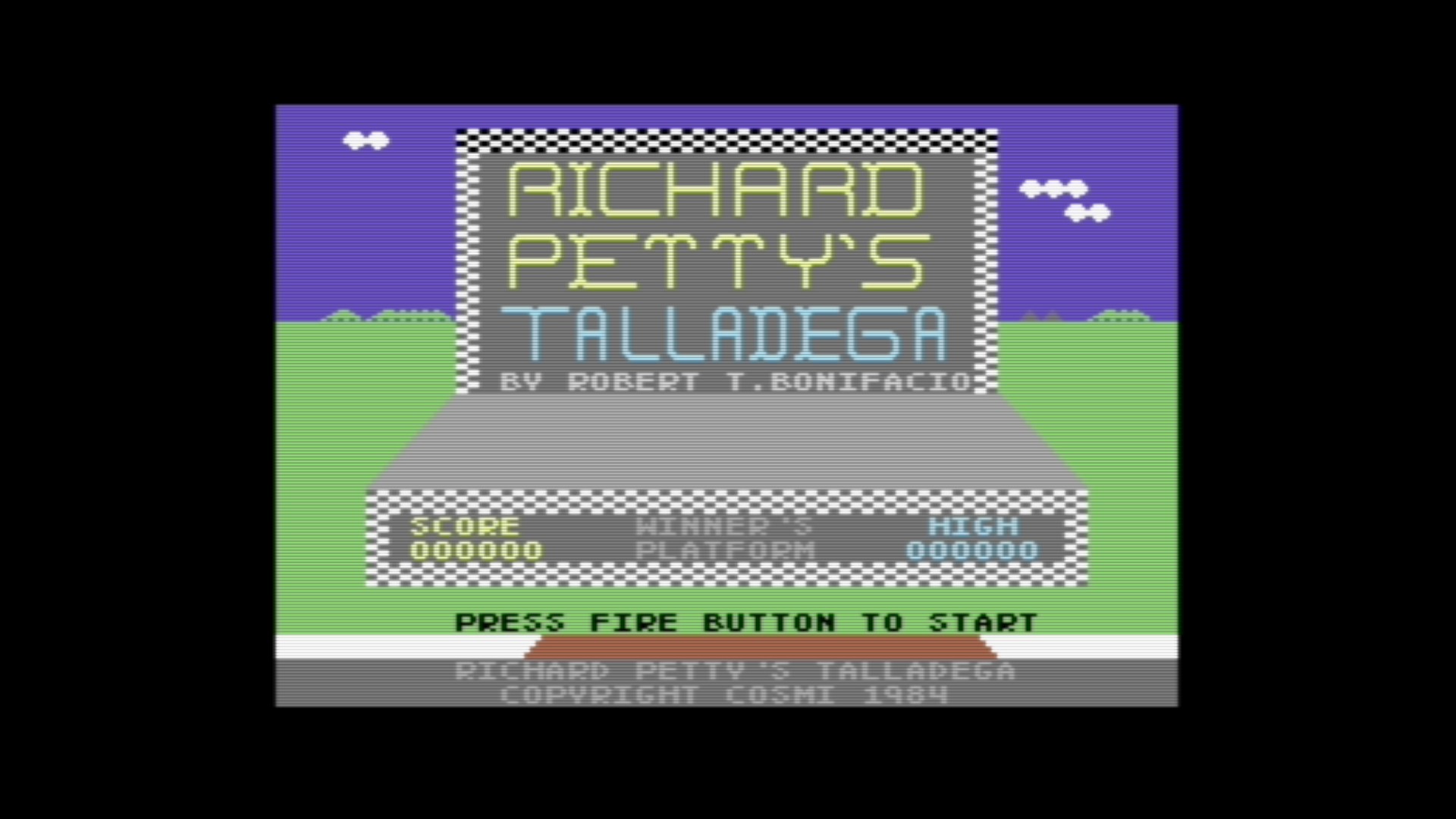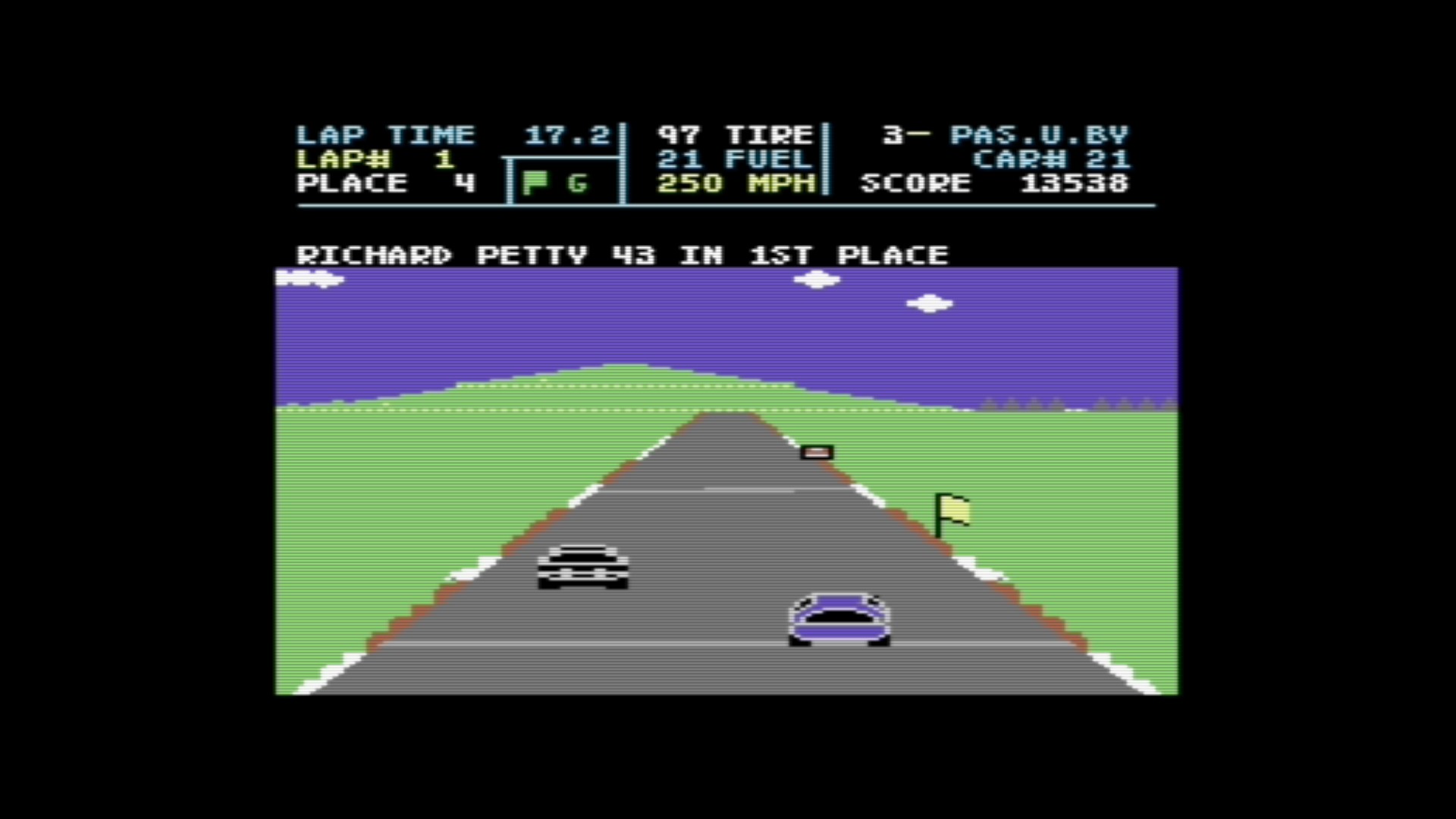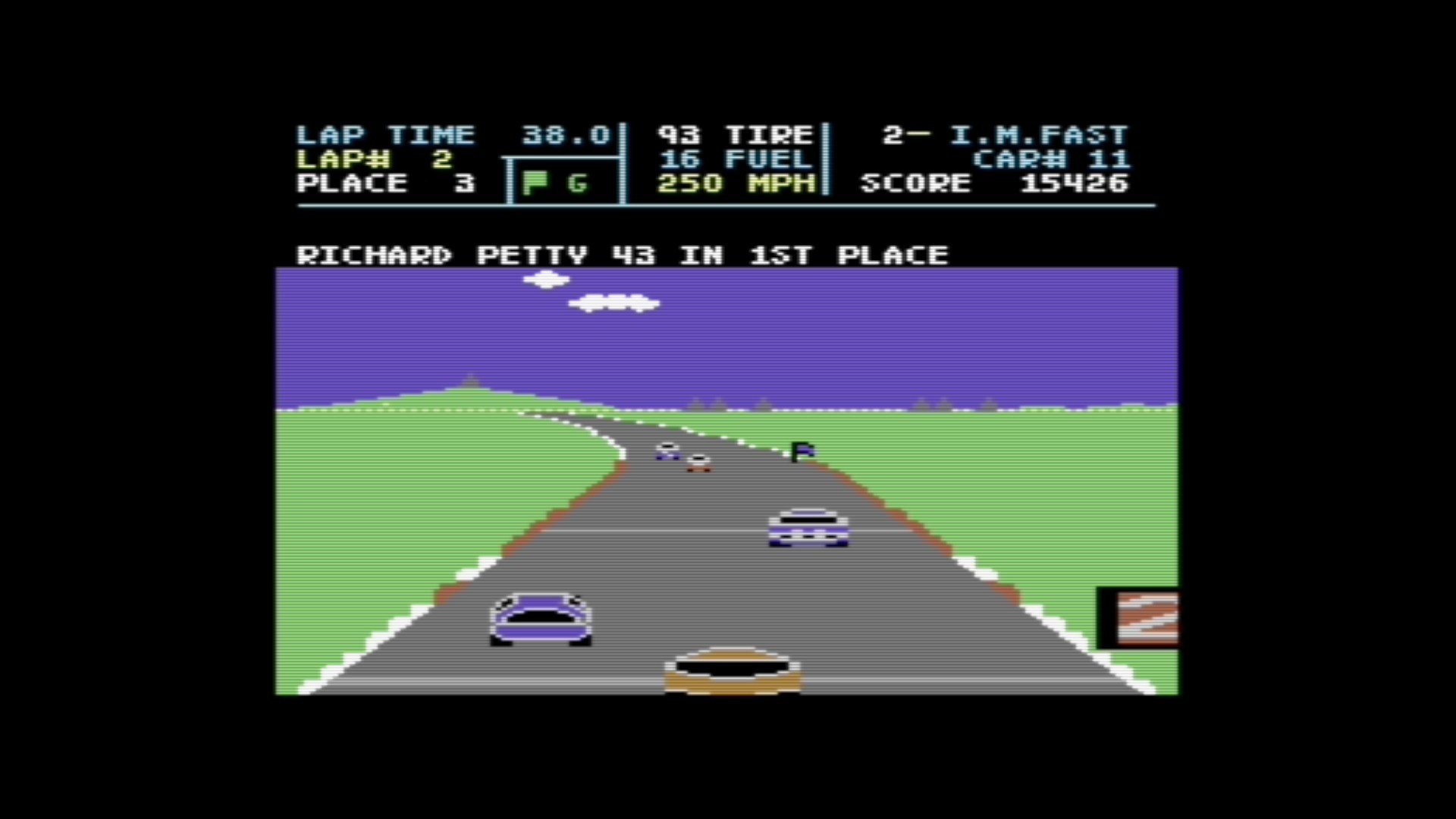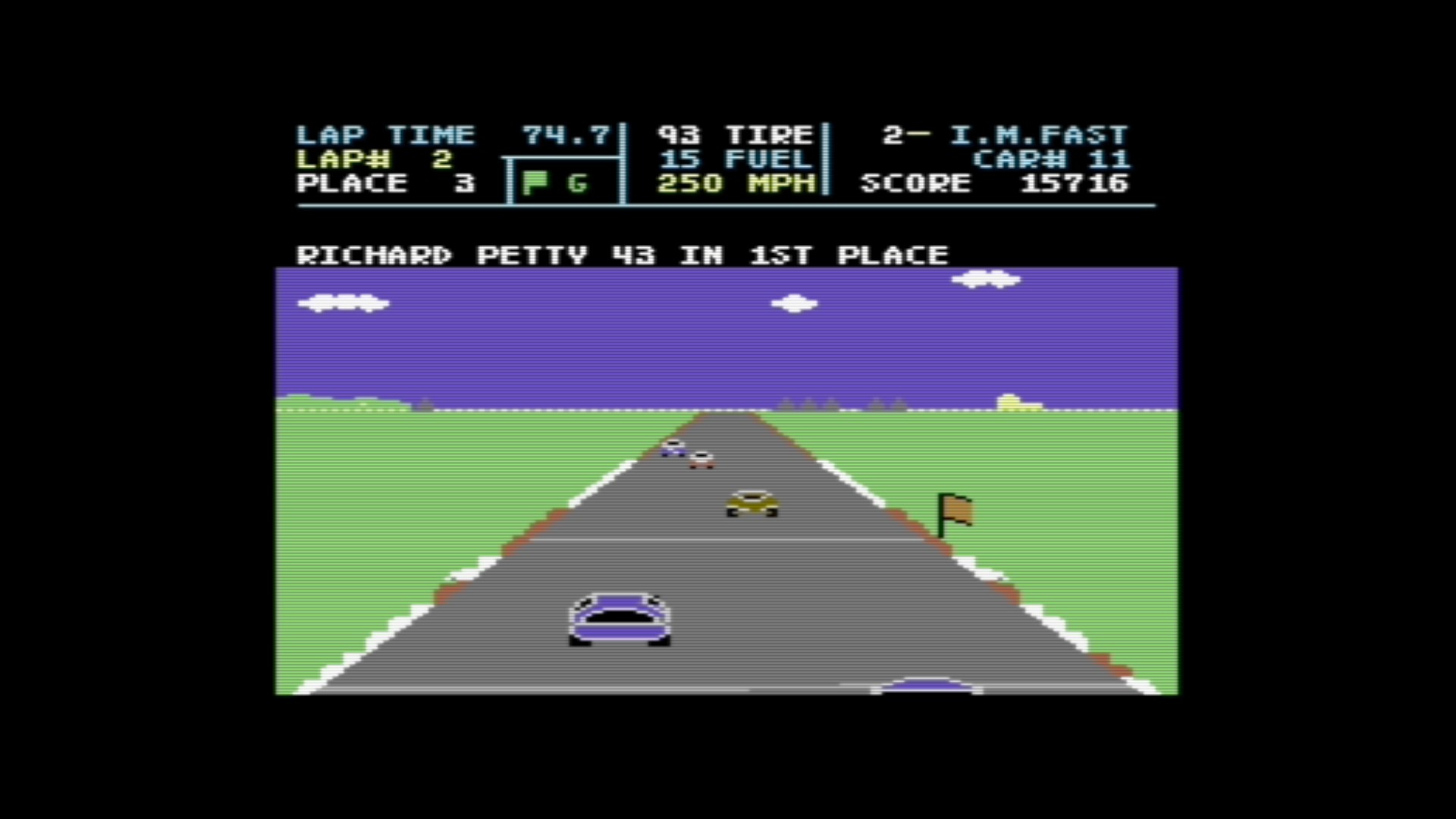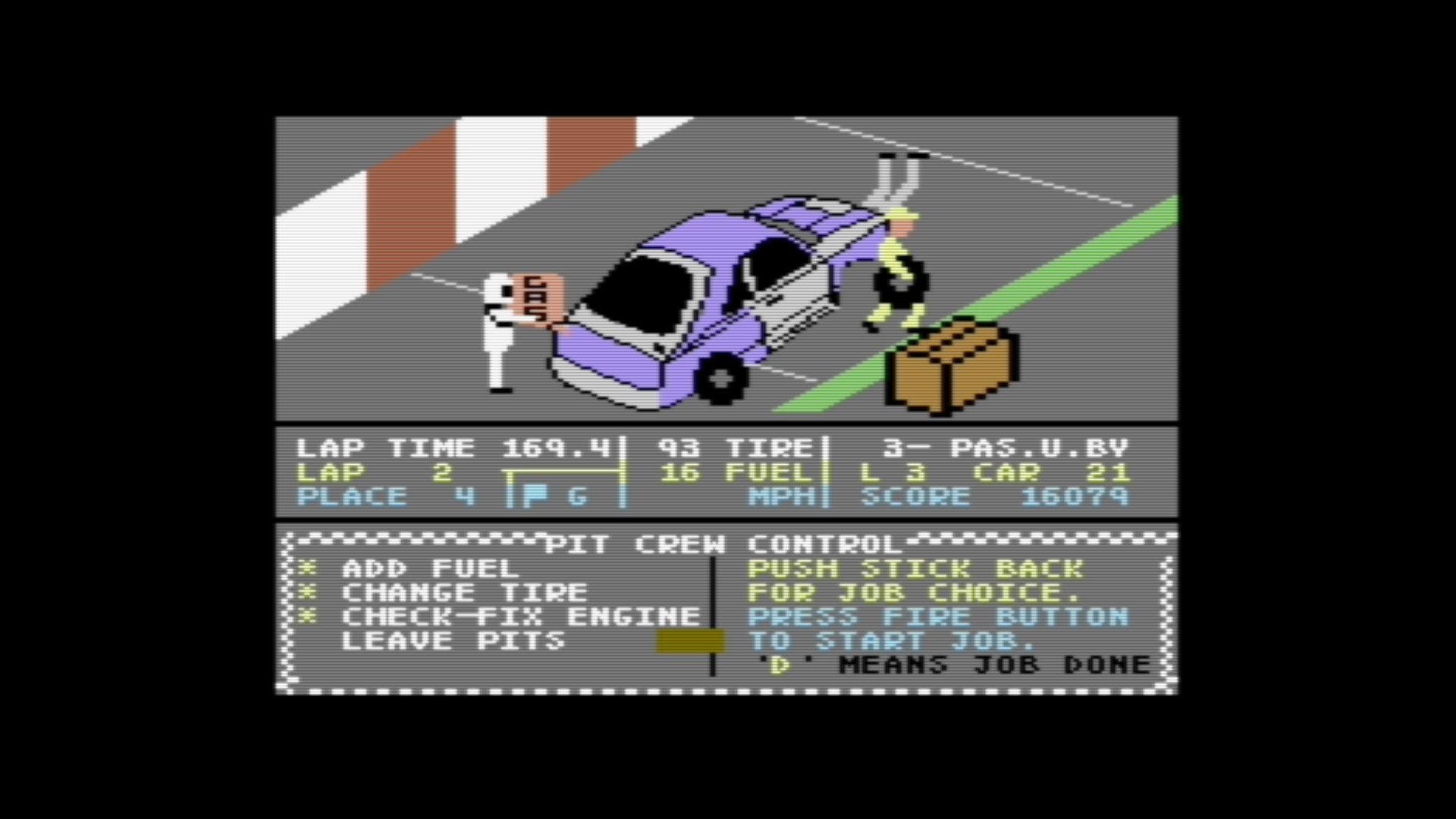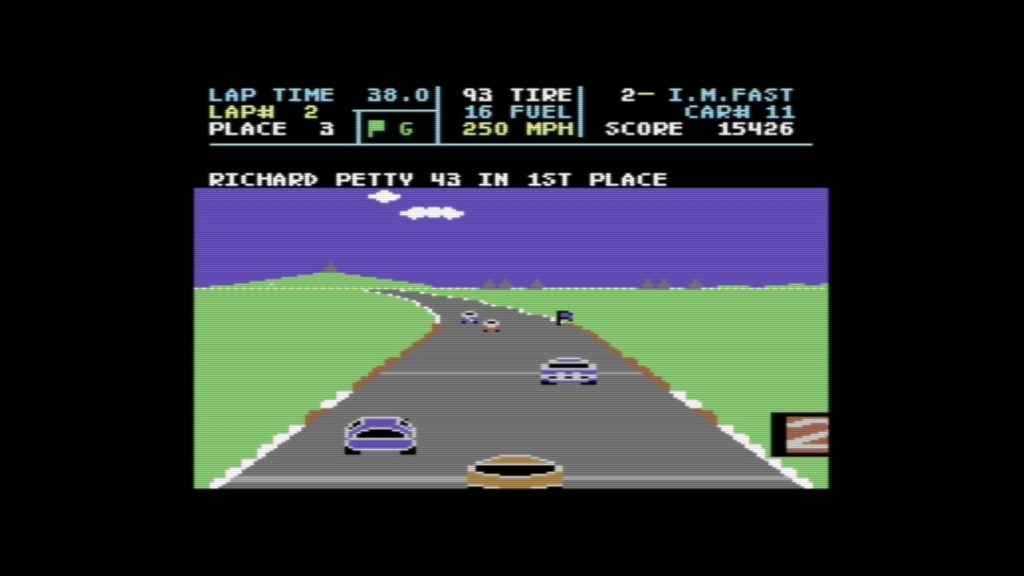Richard Petty’s Talladega Review
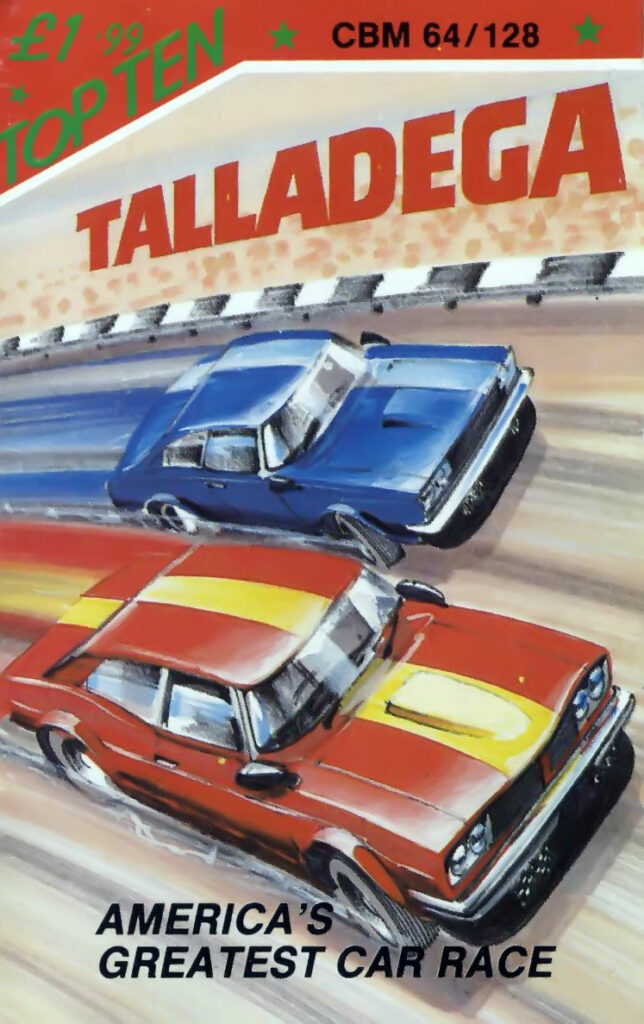
The first ever NASCAR racing game which also features turbo-boosts and car maintenance.
Introduction
Richard Petty, king of the NASCAR Super Stocks race scene, challenges you to a grueling race around the Talladega Superspeedway in Alabama USA. 18 professional drivers will race there for the ultimate victory – fame, money and glory. As a newcomer to the stock car scene you have a lot to prove if you want to be a top racer. But don’t push yourself too hard! NASCAR is the perfect high-speed racing thrill, but it is also a very dangerous sport.
The Game
Richard Petty’s Talladega is an original NASCAR racing game for the home computers Commodore 64 and the Atari XL. This is the first NASCAR related video game ever released and it is officially licensed to feature Richard Petty as a character that appears in the game.
You play as a rookie driver who’s looking to win the 30 laps long Talladega race. First, you must qualify for the main event by racing a qualification run. Once you’re in the main event, you must fight your way through the racing positions and at the same time keep an eye out for tire wear, fuel levels and engine problems.
The game is played from a third-person perspective, so you’ll see your own car from behind as you race around the track. Your car is equipped with a turbo boost feature, so once you’ve reached the max speed of 250 mph you can enable the turbo to reach a whooping 294 mph. Doing this has its obvious advantages, but it quickly drains your fuel. Driving too close to the curbs will wear your tires, and if you’re unlucky your engine will get damaged from all the aggressive driving. All these problems can be fixed in the pit stop and you can visit it as often as you like. With some skillful driving, luck and planning you’ll be able to minimize the visits to the pit stop and thus maximize your racing time.
Content
There are three different races to play, namely; the Tri Oval 30 laps, Random 30 laps and Random Repeat. The names of the races are self explanatory – the Random races take place on a randomized track, and it is different every time you play. Repeat just means that there is no end to the race after 30 laps. Instead it keeps on going forever. Each race has a qualification run that you must finish in a set time in order to be allowed to race. Your performance on the qualification run will decide your starting position in the main event. If you fail the qualification your game is over and the you’re taken back to the main screen. Otherwise the game ends once you’ve raced the 30 laps, or your car breaks down. Thus, each game consists of one single race and a qualification run.
At any time during a race, you can see your current position, score, lap time and status of your car on the top of the screen. It’s worth noting that engine problems aren’t noted there though – you’ll know that your engine needs fixing if you no longer can’t reach the 250 mph max speed.
The lap time counter is, as far as we can tell, broken. Depending on what you do, it counts time differently. The most obvious example is that when you’re skidding through a bend, it counts time faster than it does when you drive on a stretch. The lap time counter is also affected by turbo-boost usage, so we’ll just say that something is definitely up with it.
Richard Petty’s Talladega is a tricky game. The competitors that you race against are some of the most notorious race drivers you’ll ever see – they’ll do anything to get in your way. A single collision will typically not wreck your car, but if you get stuck between the edge of the road and another car, you can be sure that your car will explode in no time. It’s best to avoid contact with the other cars altogether, but this isn’t easy because they’ll all work together against you. When they gang up on you, they’ll try to position themselves in front and beside you, so that you are effectively locked down. The only way out of it is to slow down. Getting through 30 laps in these circumstances is quite a challenge, to say the least.
The competitors’ cars never need to enter the pit stop and they never break down either. Despite this, the game is fair – your competitors aren’t as fast as you, and they don’t have a turbo-boost. It all balances out pretty well, but the game is still very challenging. Without a doubt, the key to victory lies in the turbo-boost.
Depending on your lap time performance, you’ll earn score. Score is obviously a big deal in this game – there is no high score table as such, but your last score is displayed on the main screen together with the best score of the play session. It’s hard to tell exactly how the final score is calculated, and with the strange lap time counter it’s probably not worth trying to figure it out either.
Maintaining your car at the pit stop is basically a matter of selecting which fixes you want to apply and wait for the mechanics to fix you up. For the most part you might as well apply all fixes (engine, tires and refill fuel) because they all take roughly the same amount of time and they can be done simultaneously.
Controls
The controls are straightforward and easy to learn – holding down the fire button acts as the gas pedal, pushing the joystick upwards will trigger the turbo-boost and pulling it down will act as the brake pedal. Your stock car moves effortlessly sideways, and only during turns it struggles to stay on the track. You can always slow down to tackle a turn, but managing the speed with any accuracy is difficult because of the limited graphics – anything but the top speed looks incredibly slow. So for example, there’s basically no visual or gameplay difference between 100 mph and 200 mph.
Graphics
The graphics are not bad considering the release date, but they do come off as a bit crude. On a positive note, the game runs very fast so there’s no frame rate issues. The sprite scaling that creates the illusion of 3D depth is a bit sloppy and it is totally disjointed from the ground movement. The track scrolls along with some minor jerkiness and the tracks look all the same. Despite these shortcomings the game has lots of charm. The racing sensation is the key aspect of any racing game, and let’s keep in mind that the Commodore 64 hardware is limited when it comes to displaying 3D style graphics. Richard Petty’s Talladega still manages to be fun to play. It’s fast, very challenging and the turbo-boost is always thrilling to use.
Sound
The main screen of the game features a botched 8-bit rendition of the traditional American song Dixie’s Land. When your car gets wrecked, a similarly modest 8-bit version of Chopin’s Funeral March plays a few notes. With that said, this game isn’t very strong on the music.
The sound effects are somewhat better – you’ll hear the engine rev up and the tires screech as you skid along the track. Using the turbo-boost will cause a distinct airplane-like noise, so you’ll instantly know when it kicks in. The other sound effects are okay too and there are some nice jingles that denote special events such as new laps and cleared qualification runs.
Summary
Richard Petty’s Talladega is well worth a play or two despite its crude graphics – the high difficulty level will keep you on the edge of your seat and there are lots of thrills to be had once you start racing for the top positions in an event. It may not be the best racing game on the platform, but it certainly is challenging and fun for a while.
